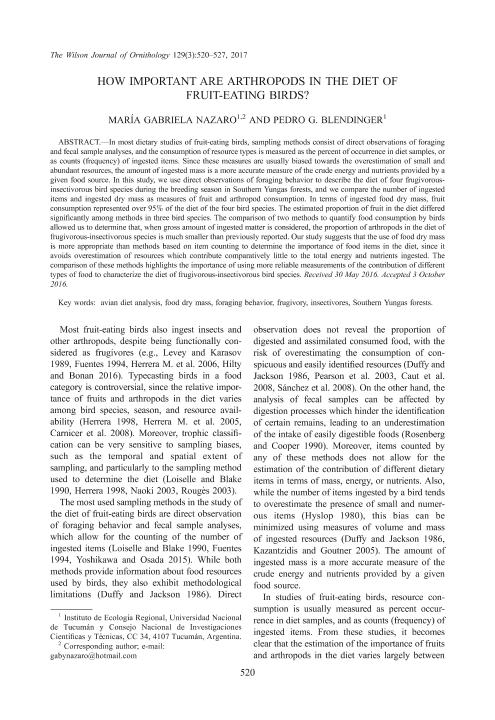Mostrar el registro sencillo del ítem
dc.contributor.author
Nazaro, María Gabriela

dc.contributor.author
Blendinger, Pedro Gerardo

dc.date.available
2018-11-22T18:13:12Z
dc.date.issued
2017-09
dc.identifier.citation
Nazaro, María Gabriela; Blendinger, Pedro Gerardo; How Important Are Arthropods in the Diet of Fruit-Eating Birds?; Wilson Ornithological Society; Wilson Journal of Ornithology; 129; 3; 9-2017; 520-527
dc.identifier.issn
1559-4491
dc.identifier.uri
http://hdl.handle.net/11336/64942
dc.description.abstract
In most dietary studies of fruit-eating birds, sampling methods consist of direct observations of foraging and fecal sample analyses, and the consumption of resource types is measured as the percent of occurrence in diet samples, or as counts (frequency) of ingested items. Since these measures are usually biased towards the overestimation of small and abundant resources, the amount of ingested mass is a more accurate measure of the crude energy and nutrients provided by a given food source. In this study, we use direct observations of foraging behavior to describe the diet of four frugivorous-insectivorous bird species during the breeding season in Southern Yungas forests, and we compare the number of ingested items and ingested dry mass as measures of fruit and arthropod consumption. In terms of ingested food dry mass, fruit consumption represented over 95% of the diet of the four bird species. The estimated proportion of fruit in the diet differed significantly among methods in three bird species. The comparison of two methods to quantify food consumption by birds allowed us to determine that, when gross amount of ingested matter is considered, the proportion of arthropods in the diet of frugivorous-insectivorous species is much smaller than previously reported. Our study suggests that the use of food dry mass is more appropriate than methods based on item counting to determine the importance of food items in the diet, since it avoids overestimation of resources which contribute comparatively little to the total energy and nutrients ingested. The comparison of these methods highlights the importance of using more reliable measurements of the contribution of different types of food to characterize the diet of frugivorous-insectivorous bird species.
dc.format
application/pdf
dc.language.iso
eng
dc.publisher
Wilson Ornithological Society

dc.rights
info:eu-repo/semantics/openAccess
dc.rights.uri
https://creativecommons.org/licenses/by-nc-sa/2.5/ar/
dc.subject
Avian Diet Analysis
dc.subject
Food Dry Mass
dc.subject
Foraging Behavior
dc.subject
Frugivory
dc.subject
Insectivores
dc.subject
Southern Yungas Forests
dc.subject.classification
Otras Ciencias Biológicas

dc.subject.classification
Ciencias Biológicas

dc.subject.classification
CIENCIAS NATURALES Y EXACTAS

dc.title
How Important Are Arthropods in the Diet of Fruit-Eating Birds?
dc.type
info:eu-repo/semantics/article
dc.type
info:ar-repo/semantics/artículo
dc.type
info:eu-repo/semantics/publishedVersion
dc.date.updated
2018-10-23T20:39:01Z
dc.identifier.eissn
1938-5447
dc.journal.volume
129
dc.journal.number
3
dc.journal.pagination
520-527
dc.journal.pais
Estados Unidos

dc.journal.ciudad
Lawrence
dc.description.fil
Fil: Nazaro, María Gabriela. Universidad Nacional de Tucumán. Instituto de Ecología Regional. Consejo Nacional de Investigaciones Científicas y Técnicas. Centro Científico Tecnológico Conicet - Tucumán. Instituto de Ecología Regional; Argentina
dc.description.fil
Fil: Blendinger, Pedro Gerardo. Universidad Nacional de Tucumán. Instituto de Ecología Regional. Consejo Nacional de Investigaciones Científicas y Técnicas. Centro Científico Tecnológico Conicet - Tucumán. Instituto de Ecología Regional; Argentina
dc.journal.title
Wilson Journal of Ornithology

dc.relation.alternativeid
info:eu-repo/semantics/altIdentifier/url/http://www.bioone.org/doi/10.1676/16-083.1
dc.relation.alternativeid
info:eu-repo/semantics/altIdentifier/doi/https://dx.doi.org/10.1676/16-083.1
Archivos asociados
